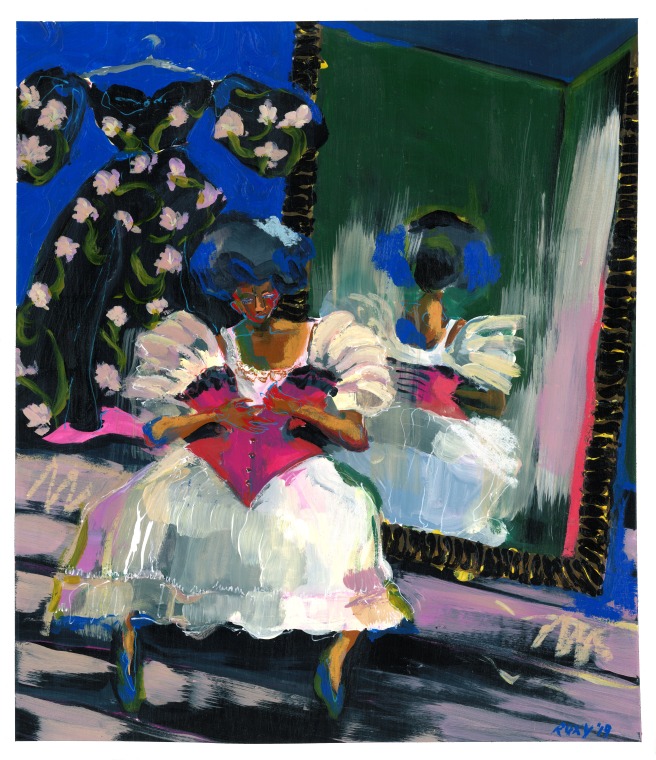This post is the third in a collaborative project with Netherlands-based artist Roxy van Bemmel (@whatsaroxy). This scheme sees Bemmel interpret garments from museum collections through a contemporary and abstract eye. Historical context about the piece chosen for analysis is provided by whatgrandmawore.

Painting of a woman with a 19th century evening dress from the Centraal Museum Utrecht, The Netherlands. Roxy van Bemmel. All rights reserved to the artist. 2019.
Centraal Museum Utrecht costume conservator described this 1895 dress as ‘a masterpiece of haute couture’ in her text A Century of Dutch Fashion. This garment was purchased by Annette Lucie Koch-van Rappard at Maison Emile Pasquier in Paris. This silk gown is distinctive because of its vibrant, floral print, combined with its embroidered collar and sleeves. It indicates a penchant for Art Nouveau motifs, known for its use of botanical forms.

4466/001-002. Evening dress (tweedelige japon). c1895. Centraal Museum Utrecht, The Netherlands. https://www.centraalmuseum.nl/nl/collectie/4466-001-002-tweedelige-japon-maison-emile-pasquier#/CM/nl/collectie/4466-001-002-tweedelige-japon-maison-emile-pasquier/slideshow/4466_001-002_08-tif
The key features @whatsaroxy wished to focus on were the large sleeves and corseted waist. For this, she analysed sleeve supports and corsets dated to a similar period from other collections. According to the garment’s object inventory, ‘the average waist circumference was only about 58 to 63 centimetres,’ a body ideal produced with a corset and the addition of ribs inserted in the bodice of the dress. The large shoulder sleeves create the illusion of an even smaller waist. Underpinnings clearly pay a crucial part in manifesting the fashionable silhouette intended for this garment.
Sleeves swelled during the 1890s, reaching their peak during the middle of the decade. The leg-of-mutton sleeves on this gown are large and high, balanced to some extent by the wideness of the skirt. During the 1890s, giant, puffed-up sleeves inflated above the line of the squared shoulder in comparison to the sleeves of the 1830s. The shape of such sleeves were held in place by stiff linings and steel supports. Wire or cane could equally produce a lighter, fuller effect. Mechanical improvements and advancements in dressmaking technology enabled more efficient support of these sleeves.
The sleeves in this gown, end towards the elbow, indicating that this gown would have been worn during the evening. By the end of the 19th century and turn of the century, large sleeves fell out of favour, emphasis shifting to the ‘S bend’ silhouette and volume to the front of the chest.
To create the painting, @whatsaroxy studied several corsets dating from the same or close to year as this garment’s production. Additionally, they studied and subsequently illustrated sleeve supports from the period. Rather than choosing to have the individual depicted in the illustration wearing her garment, @whatsaroxy has chosen to hang the garment in the background, with an emphasis on the sitter and their undergarments.

Sketches of 19th century corsets belonging to the Victoria and Albert Museum and 19th century sleeve supports belonging to The Metropolitan Museum of Art. Roxy van Bemmel. All rights reserved to the artist. 2019.
They have chosen to portray the sitter in a state of undress, positioned in front of a mirror so the viewer is able to see the reflection of the laced corset. Such a curatorial technique can really make a difference to how the viewer of in this case, a painting, or an object in the museum, can construe a garment. A recent trip to the Victoria and Albert Museum’s fashion galleries demonstrated this practice in action. One can see the back of garments that may be missed when a frontal position of the sitter is commonly chosen, or when a garment is mounted and faced towards the front of a display case.
As ever, you can find more information about the project between @whatgrandmaworeand @whatsaroxy in previous blog posts, or through our Instagram stories!

